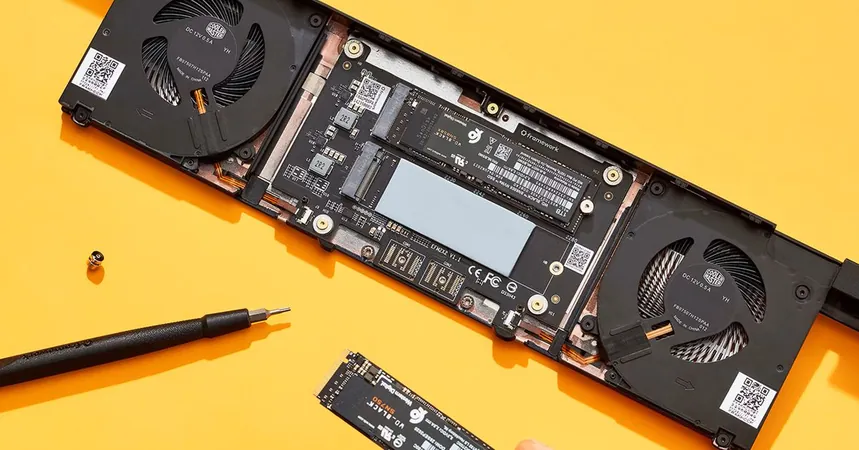
The Urgent Call for Responsible Space Conduct Amidst Looming Collision Risks in Low Earth Orbit
2024-12-16
Author: Jacob
As the race to expand our presence in space intensifies, the statistics reveal a sobering reality. More than 10,000 operational satellites populate low Earth orbit (LEO) today, with an additional 3,500 decommissioned satellites lurking in silence. Coupling this with tens of thousands of larger debris pieces and a staggering 100 million fragments smaller than 10 centimeters, the risk of satellite collisions continues to escalate dramatically. With predictions indicating that the number of satellites could soar to anywhere between 20,000 to 58,000 by 2030, we are looking at an unprecedented increase in orbital congestion.
This alarming rise in satellite traffic has rendered traditional methods of collision risk assessment and avoidance obsolete. In fact, a typical satellite operator currently deals with over 60,000 alerts weekly. Notably, SpaceX’s expansive Starlink constellation has executed nearly 50,000 collision avoidance maneuvers in just six months, averaging an astounding 275 maneuvers per day.
The Importance of Accurate Real-Time Data
The cornerstone of effective collision avoidance lies in having precise, real-time data about satellites’ locations and planned maneuvers. This critical information, referred to as ephemeris, is vital for maintaining a safe orbital environment. Unfortunately, many private companies are not sharing this information to the necessary extent. The U.S. Space Force’s tracking capabilities have limitations, making it imperative that satellite operators step up sharing this essential data with the industry.
Astoundingly, only 3% to 4% of satellite operators exchange ephemeris information with others. While the concern for proprietary data is valid, protecting this information at the expense of safety is a shortsighted approach. The satellite operators’ exclusive knowledge about their satellites could be transformative if shared; as the industry evolves, it’s critical that a change in mindset occurs, embracing ephemeris sharing as a fundamental industry standard.
Enhancing Maneuverability and Responsiveness
The congestion in LEO and subsequent risks of conjunction events are compounded by the absence of active propulsion systems in many commercial satellites, particularly smaller ones. This deficiency severely limits the options for avoiding potential collisions. Recent incidents involving commercial operators exemplify the urgent need for enhanced maneuverability: two satellites faced a high-risk conjunction that required complex maneuvers which were ultimately executed through a method known as differential drag, showcasing the precarious and makeshift solutions now required. This incident starkly highlights the vital necessity for more reliable propulsion technologies across all satellite classes.
Emerging advancements in small satellite propulsion technology show promise. As we innovate, it’s essential that operators proactively integrate these systems to ensure that all satellites can respond nimbly in high-stakes situations.
The Need for Robust Mission Operations
With more companies and nations launching rockets than ever before, the dynamics of LEO are transformed, amplifying the importance of robust mission operations. Satellite operators need adequately staffed teams capable of managing both mundane and critical incidents effectively. A well-resourced operational team is essential to navigate the increasing number of conjunction warnings.
Furthermore, automation is becoming indispensable in modern operations. Investing in sophisticated automated systems for space traffic management will significantly boost situational awareness and streamline the process for managing conjunction events.
Confronting the Future
As risk factors continue to climb in LEO, it is paramount that industry stakeholders cooperate to implement proactive measures to mitigate collision risks. If we are to preserve the operational integrity of space for future generations, a commitment to responsible and active participation in cultivating a sustainable orbital environment is non-negotiable.
The challenges and opportunities in low Earth orbit are significant. By addressing issues of data sharing, enhancing propulsion capabilities, and investing in operational resources, we can pave the way for a safer and more sustainable approach to our exploration and utilization of space. The stakes are high, but the potential rewards of a cooperative and responsible industry approach are invaluable.









 Brasil (PT)
Brasil (PT)
 Canada (EN)
Canada (EN)
 Chile (ES)
Chile (ES)
 España (ES)
España (ES)
 France (FR)
France (FR)
 Hong Kong (EN)
Hong Kong (EN)
 Italia (IT)
Italia (IT)
 日本 (JA)
日本 (JA)
 Magyarország (HU)
Magyarország (HU)
 Norge (NO)
Norge (NO)
 Polska (PL)
Polska (PL)
 Schweiz (DE)
Schweiz (DE)
 Singapore (EN)
Singapore (EN)
 Sverige (SV)
Sverige (SV)
 Suomi (FI)
Suomi (FI)
 Türkiye (TR)
Türkiye (TR)